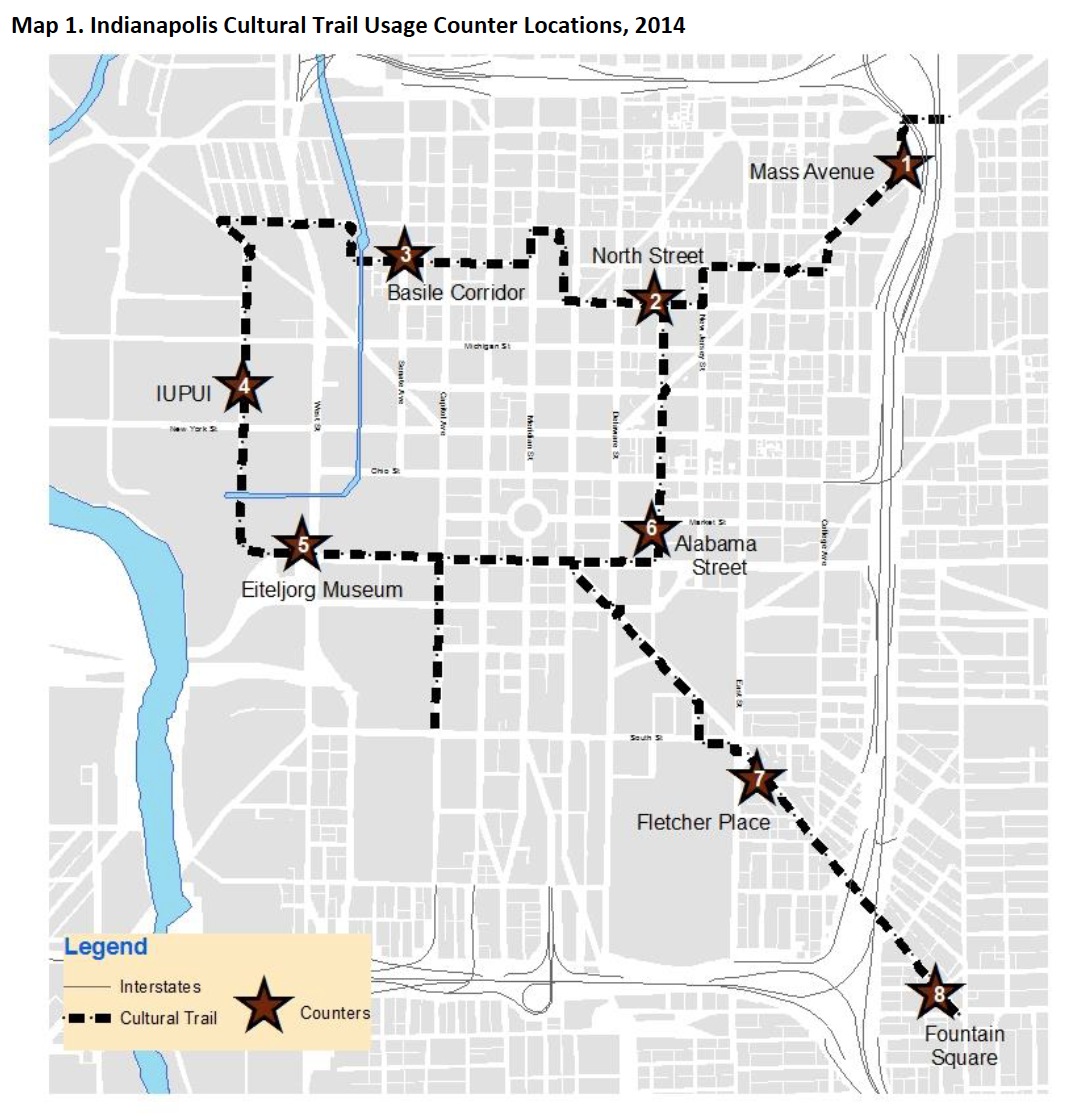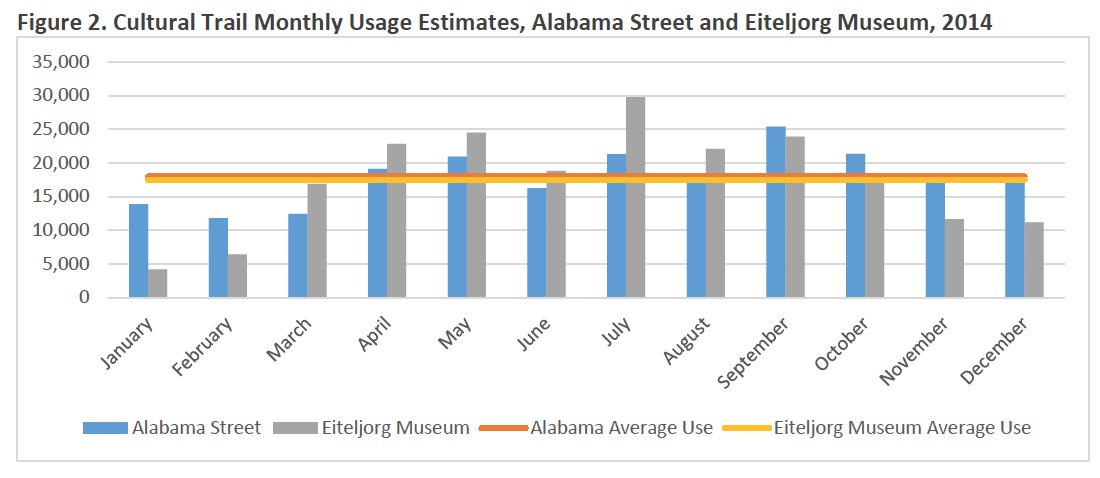INDIANA UNIVERSITY PUBLIC POLICY INSTITUTE
Executive Summary
With construction of the Indianapolis Cultural Trail: A Legacy of Gene and Marilyn Glick (Trail) complete, it is time to begin to assess the Trail’s impact on the properties and businesses near the Trail and on the people using it. This report focuses on estimates of usage, surveys of users and businesses along the Trail, change in property values along and near the Trail, and the estimated fiscal impact of the Trail.
As this analysis began soon after the completion of the Trail, the results should be considered preliminary and provide a benchmark for future analyses.
Key findings
Trail usage along the Trail exceeds most other Indianapolis trails and greenways
Eight counters were deployed with at least one counter located along each of the main segments of the Trail. Counter locations were selected in an effort to determine Trail usage and connectivity as opposed to counts at congested areas or at intersections. Therefore, these numbers are conservative estimates by segment; the actual usage is probably much higher. The lowest annual total (47,654) was recorded at Fletcher Place and the highest along Alabama Street (214,829). Some segments recorded higher counts than all other Indianapolis trails besides the Monon Trail—the most heavily utilized in the system.
Users feel safe on the Trail
Regardless of the reason for using the Trail, feeling safe and secure while on it is vital. When asked, over 95 percent of respondents feel that the Trail is safe and secure.
Business owners along the Trail have heard the same sentiment and are benefiting from this perception. Owners reported the Trail has increased the activity in the area and they enjoyed seeing more people walking around Fountain Square and Fletcher Place, especially when they visited stores and restaurants along Virginia Avenue. The owners felt that the Trail has offered greater connectivity to Eli Lilly and downtown, creating a more positive atmosphere and attracting more affluent visitors to the southern end of the Trail.
Exercise and recreation is the primary reason for use
Given the continued emphasis on the need for increased physical activity, it is encouraging to see exercise and recreation as the primary use for those who were surveyed. As most users surveyed were walkers, these numbers underrepresent those running or biking on the Trail. For that reason, the numbers exercising on the Trail are likely higher.
Over half of the respondents use the Trail every day or several times a week. Those who use the Trail every day represent one-quarter of survey respondents. Using the Trail to commute to work was the second highest use for Indianapolis and metro area residents.
Businesses located on the Trail have hired additional employees
Over half of the owners indicated they have seen an increase in customers since the Trail opened, and 48 percent indicated they have seen an increase in revenue. While Mass Avenue and Fountain Square report a larger increase in customers than revenue, Fletcher Place reports a higher increase in revenue than customers.
Several operators indicated the revenue and/or customer increases led to the creation of additional full-time and part-time positions. In total, based on business operator responses, a range of 40 to 50 full-time positions and nearly 50 part-time positions were added. Some of the new jobs created were from new businesses opening up, and based on the survey results, 25 percent of those businesses established at that location because of the Trail.
Other actions taken in response to the increases included expanding business hours and adding new products or services to their business models.
Property values have increased along and near the Trail
Using GIS software, the gross assessed value of the parcels within 500 feet of the entire Cultural Trail were analyzed to calculate the change in assessed value. The change in total assessed property value, from 2008 to 2014, was an increase of $1,013,544,460, with 25 properties accounting for 68 percent of this increase. These properties are a mix of commercial, residential, and lodging establishments, including some of the largest downtown property and development projects.
There were 30 properties that experiences an increase in assessed value over $725,000. The largest increase was $62,306,700. There were 14 properties which decreased over $725,000. The largest decrease was $3,528,200.
User reported spending and economic impact tied to Trail usage
All users surveyed were asked how much they planned to spend while participating in the following activities: staying in a hotel, eating at a restaurant, shopping at any stores, attending a theater or cultural event, or other activities. From the 558 surveys collected, 32 percent indicated they would spend money while doing at least one activity. Ten percent of the users reported they would spend money participating in more than one activity. The average expected expenditure was $53, with hotel spending the highest and restaurant spending second.
The anticipated economic impact was calculated for all categories that respondents were asked to estimate spending. At this level of estimated spending, the anticipated economic impact that any segment of the Trail would achieve ranges from $963,000 to $3.2 million.
Thirty percent of the Indianapolis users indicated they planned on spending money while on the Trail. Over half (63 percent) of those respondents indicated the spending would occur at a restaurant. Of the total visitors surveyed, 47 percent indicated that they had or planned on spending money during their trip on the Trail. Visitors had a higher total anticipated economic impact than Indianapolis area users. At the highest usage segment, the economic impact could be $1.9 million compared to the Indianapolis user amount of $1.2 million for the same segment.
An eye on the future
By all indications, the Indianapolis Cultural Trail: A Legacy of Gene and Marilyn Glick is a tremendous success. It is well-liked and utilized. Likely economic impacts are already being felt in the community. Yet, there is potential for more. There appears to be an opportunity for greater collaboration and coordination with neighborhoods and business owners along the various segments of the Trail. This is a community asset with potential for far-reaching impact. With construction complete, the focus may now shift to maximizing the capacity of this world class amenity.
Download full version (PDF): Assessment of the Impact of the Indianapolis Cultural Trail
About the Indiana University Public Policy Institute
policyinstitute.iu.edu/
The IU Public Policy Institute delivers unbiased research and data-driven, objective, expert analysis to help public, private and nonprofit sectors make important decisions that directly impact quality of life in Indiana and throughout the nation.
Tags: Bike Trail, IN, Indiana, Indiana University, Indiana University Public Policy Institute, Indianapolis, IU, Recreation Trail








 RSS Feed
RSS Feed